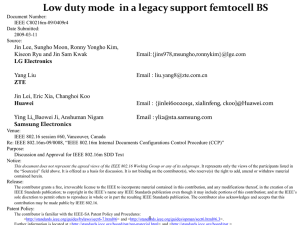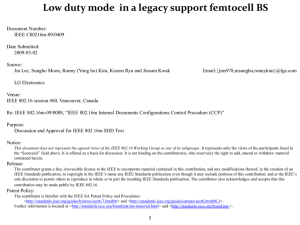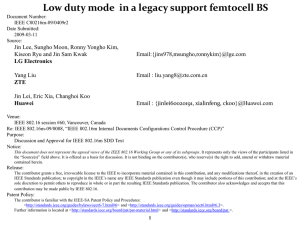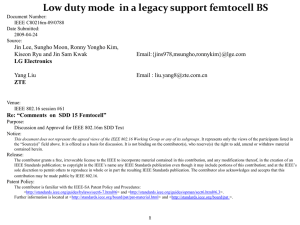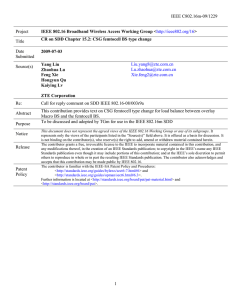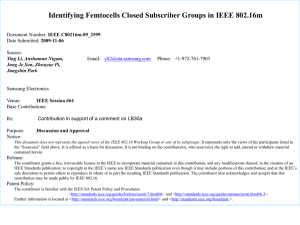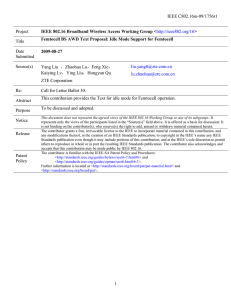Low duty mode in a legacy support femtocell BS
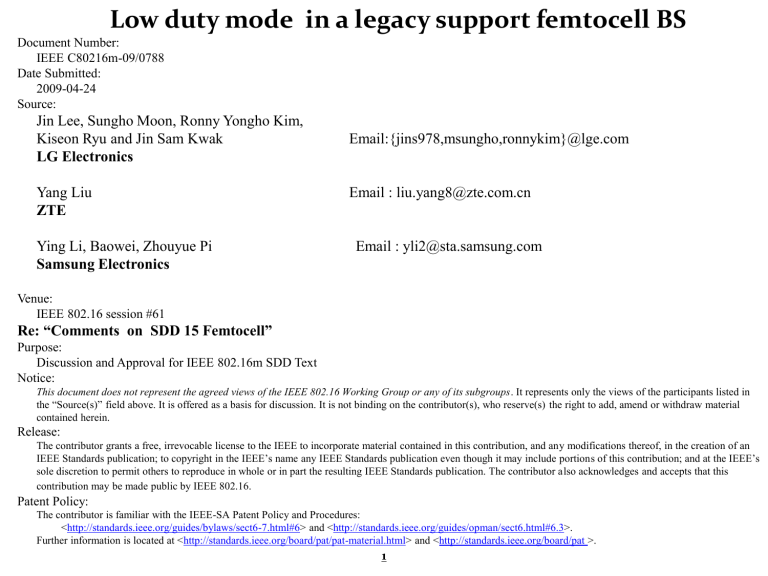
Low duty mode in a legacy support femtocell BS
Document Number:
IEEE C80216m-09/0788
Date Submitted:
2009-04-24
Source:
Jin Lee, Sungho Moon, Ronny Yongho Kim,
Kiseon Ryu and Jin Sam Kwak
LG Electronics
Email:{jins978,msungho,ronnykim}@lge.com
Yang Liu
ZTE
Email : liu.yang8@zte.com.cn
Ying Li, Baowei, Zhouyue Pi
Samsung Electronics
Email : yli2@sta.samsung.com
Venue:
IEEE 802.16 session #61
Re: “Comments on SDD 15 Femtocell”
Purpose:
Discussion and Approval for IEEE 802.16m SDD Text
Notice:
This document does not represent the agreed views of the IEEE 802.16 Working Group or any of its subgroups . It represents only the views of the participants listed in the “Source(s)” field above. It is offered as a basis for discussion. It is not binding on the contributor(s), who reserve(s) the right to add, amend or withdraw material contained herein.
Release:
The contributor grants a free, irrevocable license to the IEEE to incorporate material contained in this contribution, and any modifications thereof, in the creation of an
IEEE Standards publication; to copyright in the IEEE’s name any IEEE Standards publication even though it may include portions of this contribution; and at the IEEE’s sole discretion to permit others to reproduce in whole or in part the resulting IEEE Standards publication. The contributor also acknowledges and accepts that this contribution may be made public by IEEE 802.16.
Patent Policy:
The contributor is familiar with the IEEE-SA Patent Policy and Procedures:
< http://standards.ieee.org/guides/bylaws/sect6-7.html#6 > and < http://standards.ieee.org/guides/opman/sect6.html#6.3
>.
Further information is located at < http://standards.ieee.org/board/pat/pat-material.html
> and < http://standards.ieee.org/board/pat >.
11
Motivation
•
When a CSG femtocell BS supports both an YMS and AMS, frame configuration of the femtocell BS will be the same as a legacy support macro BS (shown in Fig 1.)
16e preamble
16m
A-PREAMBLE
Switching
Point
16e preamble
16m
A-PREAMBLE
Switching
Point
16e preamble
16m
A-PREAMBLE
Switching
Point
16e DL 16m DL 16e
UL
16m UL
5 ms Radio
Frame
5 ms Radio
Frame
5 ms Radio
Frame
Fig 1. Legacy support macro BS
•
However,
• If none of the CSG YMS exists within the overlay macro BS of its CSG Femtocell
BS,
– Unnecessary access signals occur from non-CSG YMSs in the Lzone
– Inessential 16e signals via Lzone (power consumable and outbreak of interference) are transmitted
• In case where none of the CSG AMS exist the overlay macro BS of its CSG
Femtocell BS, the non CSG AMSs will keep trying to access the femtocell BS in the MZone
•
Therefore, a CSG femtocell BS should support low duty mode (defined in SDD 15.7) of L/MZone separately upon the presence of a CSG YMS/AMS within the overlay macro BS of its CSG Femtocell BS 2
Low duty mode in a legacy support femtocell BS
Low duty mode of LZone
If none of the CSG YMSs are within the overlay macro BS of its CSG Femtocell BS,
Frame configuration would be :
16m
A-PREAMBLE
Low duty mode of MZone
If none of the CSG AMSs are within the overlay macro BS of its CSG Femtocell BS,
Frame configuration would be :
16e preamble
16m DL zone
16m UL zone
5 ms Radio
Frame
Fig 2. Low duty mode of LZone
16e DL 16e
UL
5 ms Radio
Frame
Fig 3. Low duty mode of MZone
Advantages
To remove interference to non CSG (Y/A)MSs
To decrease unnecessary access signaling from non CSG (Y/A)MSs
Usage Scenarios
Macro BS 1
16e DL
CSG list
111
222
16m
DL
16e
UL
16m
UL
AMS: 111
YMS: 222
CSG list
111
222
16m
DL
16m
UL
Macro BS 1
AMS: 111
16e DL
CSG list
111
222
16e
UL
Macro BS 2
Macro BS 1
Case 1 Case 2
CSG list
111
222
YMS: 222
Macro BS 2
AMS: 111
Case 3 Case 4
YMS: 222
Macro BS 2
Macro BS 1
YMS: 222 AMS: 111
Macro BS 2
Proposed SDD Text
15.7 Low –duty Operation Mode
When an MS leaves or enters the overlay macro BS of its CSG Femtocell BS, the network may signal the CSG Femtocell BS to enter low-duty operation mode or normal operation mode, respectively. Handover signaling or location update signaling may trigger such operation. In case a CSG Femtocell BS supports both AMS and YMS, the network may signal the CSG Femtocell BS to stop or start transmission of LZone/MZone when an YMS/AMS leaves or enters the overlay macro BS of its CSG Femtocell BS respectively.
The CSG Femtocell BS switches between the low-duty operation mode and the normal operation mode when it receives requests from the overlay macro
BS, the core network, or an MS for network entry, HO, or the exit of the sleep mode.The low-duty operation mode shall not impact the support for emergency service and E911 .
